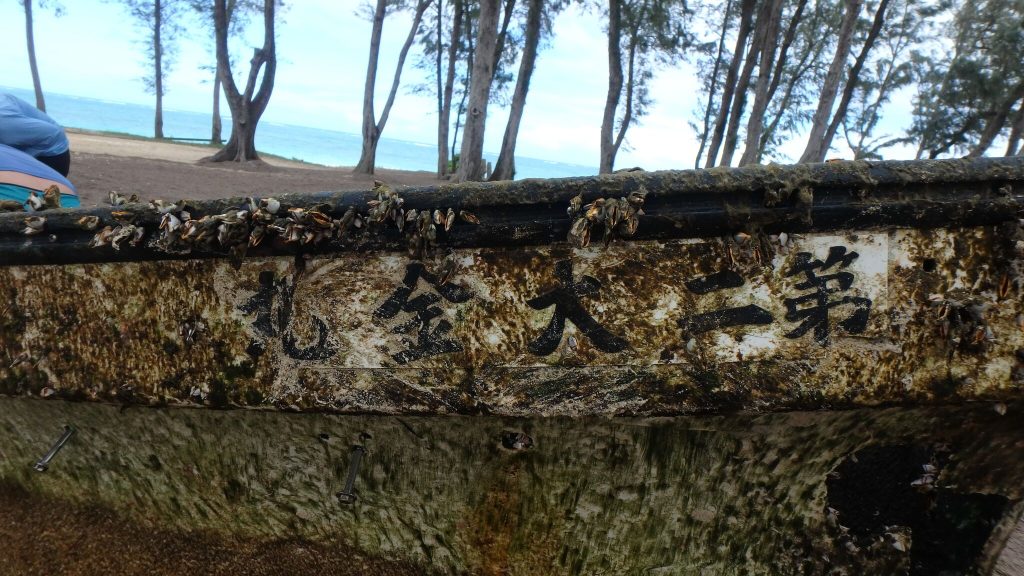Japan Gifted $5M to 5 States for Tsunami Debris Cleanup
After the devastating tsunami generated by the 9.0-magnitude earthquake that struck the coastal areas of Japan’s Tōhoku Region on March 11, 2011, the Japanese Ministry of the Environment estimated that 1.5 million tons of floating debris had been swept into the ocean.
This unprecedented single pulse of marine debris was eventually swept out to sea by oceanic currents and entered circulation in the North Pacific Ocean. The debris impacted western shores of the continental U.S., Canada and the Hawai‘ian Islands.
In 2013, the State of Hawai‘i received a portion of a $5 million diplomatic monetary gift offered to the United States by the government of Japan. The gift was intended to help the affected U.S. states address Japan tsunami marine debris or “JTMD”.
An initial distribution of $250,000 was made to each of the affected states: Hawai‘i, Alaska, Washington, Oregon and California.
In Hawai‘i, the Department of Health represented the State in a Memorandum of Agreement with National Oceanic and Atmospheric Administration, which was designated as the administrator of the JTMD Gift Fund.
The Department of Land and Natural Resources was designated as the expending agency, so in November 2013, the funds were transferred from DOH to DLNR and subsequently used to support projects in three general areas: removal, aquatic invasive species monitoring and detection.
After the initial distribution of $250K to each of the five Pacific states, the remainder of the $5 million gift fund was held in reserve for specific subsequent requests.
This diplomatic monetary gift was unprecedented in U.S. history. Managing it at national and state levels required adapting existing protocols for accounting and expenditures, and sometimes processing could be a bit challenging.
In the end, however, the diplomatic gift helped fill a gap for the previously unfunded liability of marine debris and through the projects it supported, bring more public awareness to this international problem.
REMOVAL PROJECTS: $91,712.66
DLNR staff routinely removes and disposes of marine debris. When an item exceeds in-house capabilities, contracted services by qualified commercial entities are procured.
- Contract for services: Removal & disposal of the side of a shipping container on Kaua‘i $3,875.51
- Landfill fee for disposal of damaged JTMD vessel on Oahu $219.90
- Contract for services: Removal of damaged JTMD vessel on Kaua‘i $8,000.00
- Contract for services: Removal & disposal of 20-foot diameter mooring buoy on Hawai‘i Island $28,500
- Purchase of a utility task vehicle for transporting heavy items out of areas inaccessible to larger vehicles and that would otherwise require access on foot $12,321.79
- Small equipment for removal of a JTMD boat by sea from a Maui beach site inaccessible to truck and trailer required for street transport $1,438.22
- Marine Debris Cleanup Project for a beach at Kanapou, Kaho‘olawe, that included transporting staff and volunteers by boat, camping for four days, transporting the collected marine debris by helicopter to Maui for final disposal at the landfill, and bringing communications staff to Maui to document the activity $24,716.12
- Reimbursement for staff time for various JTMD removal activities during 2013-2015 $12,641.12
AQUATIC INVASIVE SPECIES MONITORING PROJECTS: $44,902.05
Marine debris can carry alien species hitchhikers attached to the debris and travel great distances via oceanic currents and wind. If successful at colonizing in new locations, some species have the potential to become invasive and disrupt local marine ecosystems. Researchers have identified over 70 non-native species associated with JTMD landing on Hawai‘i shorelines.
In response to the concern of establishment of non-native species via JTMD, monitoring was conducted to investigate JTMD biofouling species in 2015. The first deployed a small team of biologists to do visual in-water surveys of nine landing sites on Kauai that were previously known to have been exposed to JTMD-transported alien species. The second project utilized advanced techniques in collaboration with other scientists monitoring JTMD landing sites in California, Oregon, Washington, and British Columbia.
- AIS Monitoring Project on Kaua‘i $3,345.87
- AIS Monitoring Project on O‘ahu $41,556.18
DETECTION PROJECTS: $69,165.46
DLNR conducted the first statewide shoreline marine debris survey to census the number and type of marine debris and identify debris accumulation sites. Aerial survey techniques and analysis were used to estimate the number and type of marine debris distributed throughout the main Hawaiian Islands In early 2015 DLNR biologists applied for a grant to conduct aerial surveys, and received partial funding ($65,000) from a collaborative international group of researchers, the North Pacific Marine Science Organization (“PICES”). The JTMD Gift Fund was used to supplement the PICES grant, enabling complete coverage of all shorelines of the main Hawaiian Islands. In the fall of 2015, the high-resolution aerial images were successfully collected, the first such effort in the State of Hawai‘i. Analysis of the images followed through a contract with the University of Hawai‘i.
- Contract for Aerial Survey of Main Hawaiian Islands $37,994.76
- Aerial Survey Post-Image Processing Contract $31,170.70
MARINE DEBRIS COORDINATOR: $44,219.83
Since marine debris response activities are conducted by various DLNR staff with many other duties, a dedicated marine debris coordinator position was created through a seven-month contract with the University of Hawai‘i. This position contributed support for all of the project areas as well as database management and outreach activities related to JTMD.














